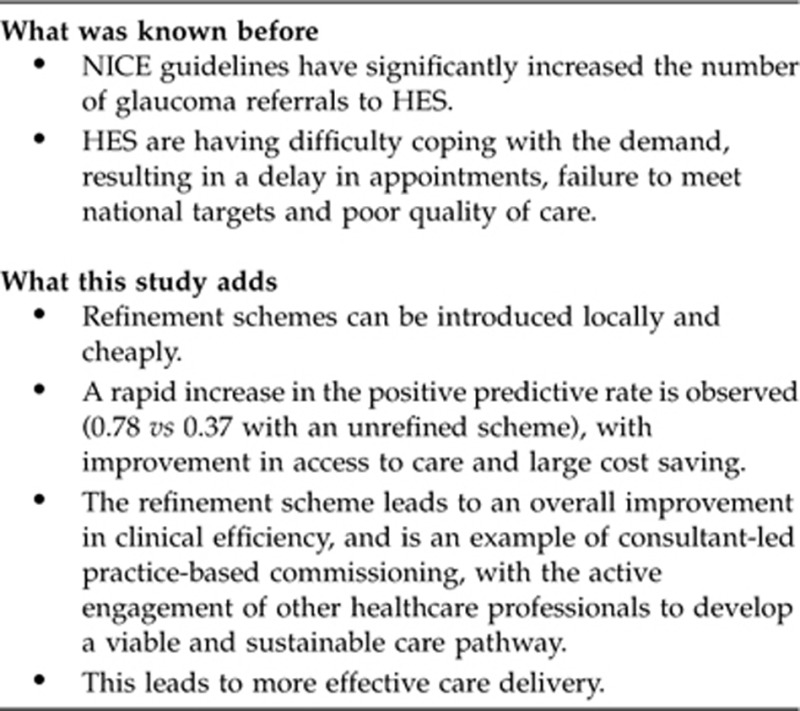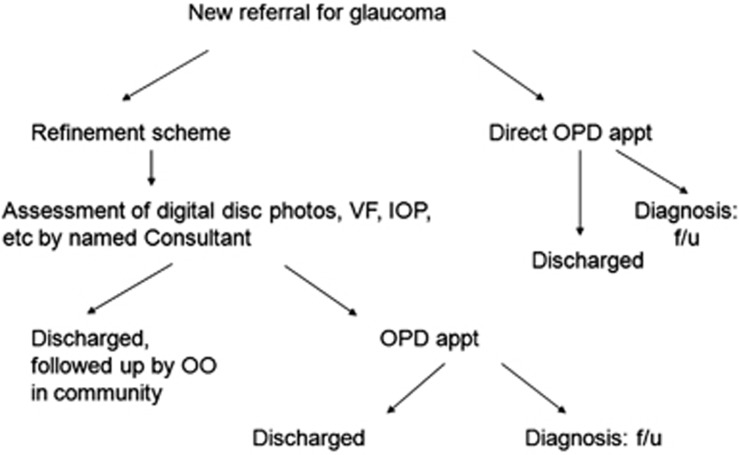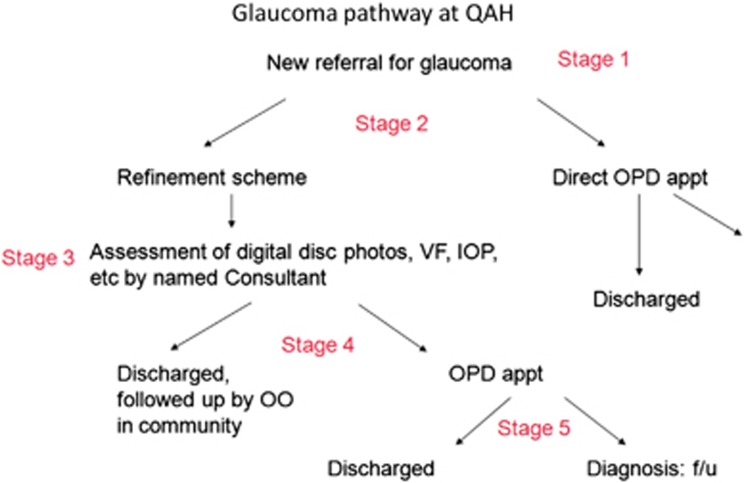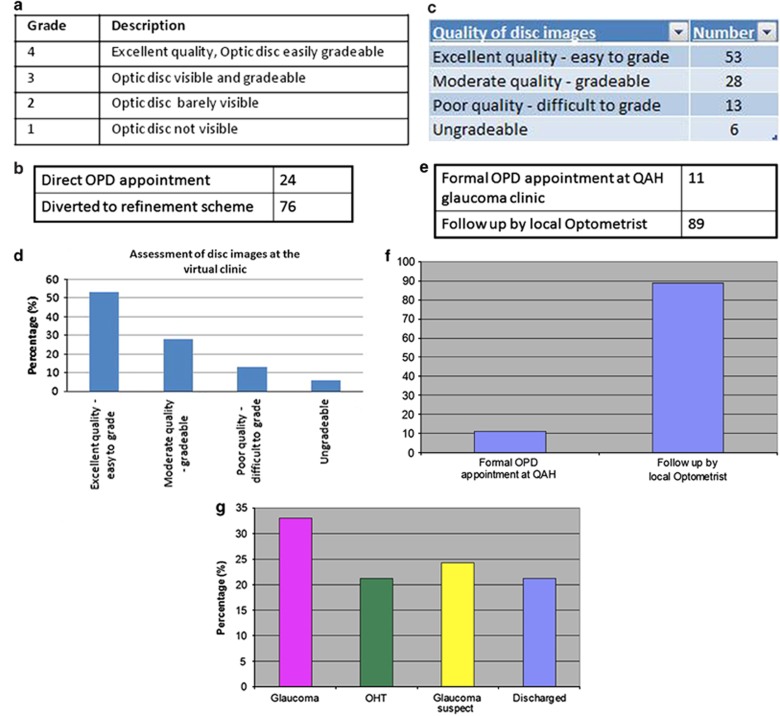Abstract
Background
Glaucoma referrals continue to impart a significant burden on Hospital Eye Services (HES), with a large proportion of these false positives.
Aims
To evaluate the Portsmouth glaucoma scheme, utilising virtual clinics, digital technology, and community optometrists to streamline glaucoma referrals.
Method
The stages of the patient trail were mapped and, at each step of the process, 100 consecutive patient decisions were identified. The diagnostic outcomes of 50 consecutive patients referred from the refinement scheme to the HES were identified.
Results
A total of 76% of ‘glaucoma' referrals were suitable for the refinement scheme. Overall, 94% of disc images were gradeable in the virtual clinic. In all, 11% of patients ‘attending' the virtual clinic were accepted into HES, with 89% being discharged for community follow-up. Of referrals accepted into HES, the positive predictive value (glaucoma/ocular hypertension/suspect) was 0.78 vs 0.37 in the predating ‘unrefined' scheme (95% CI 0.65–0.87). The scheme has released 1400 clinic slots/year for HES, and has produced a £244 200/year cost saving for Portsmouth Hospitals' Trust.
Conclusion
The refinement scheme is streamlining referrals and increasing the positive predictive rate in the diagnosis of glaucoma, glaucoma suspect or ocular hypertension. This consultant-led practice-based commissioning scheme, if adopted widely, is likely to incur a significant cost saving while maintaining high quality of care within the NHS.
Keywords: glaucoma, referrals, refinement scheme, virtual clinics, digital technology
Introduction
The management of patients with ocular hypertension and glaucoma amounts to a large proportion of the workload within Ophthalmology units throughout the United Kingdom, and indeed the world. National Institute of Clinical Excellence (NICE) guidelines published in April 2009 altered the referral and management criteria of patients with glaucoma or ocular hypertension.1 Combined with the simultaneous release of guidance from the Association of Optometrists (indicating that all optometrists should refer patients with an intraocular pressure (IOP) of 21 mm Hg or above to hospital eye services (HES)),2 a significant burden upon secondary care glaucoma services resulted throughout the United Kingdom, already coping with a 9% year on year increase in referrals. Indeed, estimates from the North London Eye study and other population prevalence surveys suggest that the number of cases of primary open angle glaucoma (POAG) and ocular hypertension will increase by one third by the year 2021.3 The subsequent increase in administration costs imparts a significant cost burden on already stretched resources. Lockwood et al,4 in his publication in Eye in 2010, demonstrated a positive predictive rate of 0.37 in the diagnosis of glaucoma or ocular hypertension in patients referred directly from community optometrists, before NICE guidelines. Following the publication of these guidelines, the positive predictive rate has dropped to 0.2. One potential consequence of the dramatic rise in referrals will be an increase in the ‘worried well' attending HES.
It is estimated that the NHS will be required to produce £20bn in efficiency savings in the next 3 years.5 With an ageing population and finite resources, it is evident that ophthalmology services will be required to find new and innovative methods to maximise capacity and maintain assessment quality. The traditional boundaries between primary and secondary care are currently undergoing major transformation in response to the government white paper ‘Our Health, Our Care, Our Say', with an emphasis on developing services in settings that are more convenient to patients.6
The Portsmouth glaucoma refinement scheme was commissioned in 2008 and led by a glaucoma consultant based in secondary care, with the recruitment of six specialist optometrists in the local community and maintenance of a multidisciplinary approach. Traditionally, referrals were received directly from a primary care physician or optometrist and placed directly into the glaucoma outpatient service, with patients often waiting 2–3 months for an appointment. The new referral structure, as outlined below (Figure 1) involves all glaucoma referrals passing to one ‘named' consultant (a glaucoma specialist) who then determined whether the referral required an immediate HES appointment, or if the patient was appropriate to be sent to the refinement scheme. Once assessed by a designated refinement scheme optometrist, patients underwent a series of tests: a standard Humphrey 24-2 visual field (SITA fast) (Carl Zeiss Meditec, Dublin, CA, USA), applanation tonometry assessment of IOP (Goldmann model; Haag-Streit, Bern, Switzerland), and a digital disc photograph (Topcon, Tokyo, Japan) (in addition to a standard optometric assessment). These digital images, along with the field test and additional findings (including an IOP measurement) are sent digitally to the named consultant. Following assessment in the ‘virtual clinic', one of the three outcomes is registered: either the patient is discharged completely, given an appointment in the Hospital glaucoma service, or followed up by community optometrists. Patients were kept informed of the process and decisions made through automatically generated letters. The consultant spent 4 h per week in the virtual clinic.
Figure 1.
Outline of the refinement scheme.
Materials and methods
The evaluation audit of the refinement scheme consisted of five arms, as illustrated below (Figure 2).
Figure 2.
The refinement scheme audit process.
Stage 1: GOS 18 assessment
The details of information contained in GOS 18 (General Ophthalmic Services form 18) referral forms for 100 consecutive patients was assessed retrospectively using a predesigned audit proforma. RCOphth and College of Optometrist guidelines formed the gold standard.7, 8 These are summarised as follows:
All referrals should include name, date of birth, address.
IOP measurement. When practitioners use non-contact tonometry (NCT), they should take four readings per eye, and then use the mean. The practitioner should only refer if the IOP mean is >21 mm Hg.
Optic disc assessment.
Central visual field assessment.
Anterior chamber depth.
Signs associated with glaucoma (pseudoexfoliation, pigment dispersion, family history of glaucoma, occludable angles).
Where optic discs appear suspicious, practitioners should state whether the disc appears normal or abnormal'.
A copy of visual field assessment should be provided.
Stage 2
The outcomes of 100 direct referrals were identified and analysed retrospectively. The proportion referred directly to hospital glaucoma service and the proportion directed to the glaucoma refinement scheme were documented.
Stage 3
The clarity of 100 consecutive optic disc digital images were documented, using a four-point grading scale (Figure 3a) agreed with the secondary care physician. The assessor was blinded from the visual field and IOP measurement, as well as the eventual virtual clinic decision.
Figure 3.
(a) The grading system of optic disc images. (b) Outcomes of initial referrals by community optometrists. (c) Optic disc grading in the virtual clinic. (d) Assessment of disc images in the virtual clinic. (e) The outcome of virtual clinic ‘appointments'. (f) A bar graph to illustrate the outcome of virtual clinic ‘appointments'. (g) The outcome of the HES appointments of patients referred through the refinement scheme.
Stage 4
From 100 consecutive referrals from the refinement scheme to the virtual clinic, the proportion ‘accepted' into the hospital glaucoma service was identified and documented.
Stage 5
The outcomes of 50 consecutive patients accepted from the refinement scheme, via the virtual clinic were documented. These were grouped into four categories; including glaucoma suspect, ocular hypertension, glaucoma, and discharged. The positive predictive rate was determined by an outcome of glaucoma/ocular hypertension/suspect divided by the total number n (n=50).
Results
Stage 1
Regarding glaucoma referrals from general optometrists, the mean age for referral was 63 years 10 months. A total of 96% had visual acuity documented using Snellen annotation, and 95% had a refraction documented. Although all referrals (100%) had an IOP measurement, the method of IOP measurement was documented in 76% (all NCT) and in 12% of referrals, 4 IOP measurements, and a mean IOP were included, the gold standard as per RCOphth and College of Optometrists' guidelines. A total of 14% had no disc assessment, 1% had anterior chamber depth documented, and 55% did not have visual field assessment. Of those that did have visual fields, there was variable use of perimetry: full threshold (4/45), suprathreshold (17/45), and unspecified in 24/45. A copy of the visual fields were provided in 12% of referrals. Optic disc appearance was assessed in 86% of cases.
Stage 2
From 100 consecutive referrals, 76% of general referrals were deemed suitable for the refinement scheme, with 24% accepted immediately into the HES (Hospital Eye Service) (Figure 3b).
Stage 3: gradeability of optic disc images
From the data the optic disc assessment was gradable 71% of the time. In three cases the view was limited due to media and/or lens opacity, in two cases the entire disc was not visible and in one case the resolution deemed too poor for grading (Figures 3c and d).
Stage 4: referrals from the refinement scheme
From the data only 11% of referrals into the virtual clinic were subsequently given an appointment in the hospital eye service (glaucoma clinic). In all, 89% did not require a hospital glaucoma outpatient appointment (Figures 3e and f).
Stage 5: outcomes of patients from the refinement scheme
The PPR is 0.78 (95% CI 0.65–0.87) for the refined scheme compared with 0.37 (95% CI 0.25–0.49) for the unrefined scheme (Figure 3g). Similarly, the diagnosis of POAG (32% vs 7%), ocular hypertension (22% vs 11%), and glaucoma suspects (24% vs 21%) are statistically more common in patients passing through the refinement scheme (see Figure 4).
Figure 4.
A comparison between ‘refined' and ‘unrefined' schemes. PPR=(diagnosis of glaucoma or OHT/total number referred).
Discussion
Stage 1 results demonstrate that new referrals from optometrists are falling some way short of RCOphth and College of optometrist guidelines. Some optometrists may not be fully aware of the guidelines requiring a detailed assessment, and may focus upon raised IOP permitting the referral to be made. Outcomes from this data included education sessions for the recruited optometrists. Ang et al,9 who demonstrated that after changes to the GOS contract in 2006, there was an increase in the true positive rate of glaucoma referrals (from 18.0% ‘preguideline' to 31.0% ‘postguideline', P=0.006) in Scotland. The overall quality of referrals, however, has increased following the widespread implementation of the guidelines in 2009.4 There is no doubt that an increase in quality of optometrist referrals towards the gold standard would improve the detection rate of the scheme even further.
Lockwood et al4 demonstrated a positive predictive value of direct referrals to HES of 0.37 using an unrefined scheme, with widespread variation in the use of perimetry by optometrists. Our data supports this continued variation in perimetry use, but a marked increase in the positive predictive rate (0.78) via the refinement scheme. The concept of utilising specialist optometrist input to streamline glaucoma referrals has been described by Henson et al.3 In the Manchester-based scheme, the use of specialist-trained optometrists to review all optometry referrals for glaucoma before accessing the HES resulted in a 40% reduction in glaucoma referrals, and a subsequent saving of £17 per patient.10 However, a similar study conducted in Nottingham found that, despite the distribution of locally agreed referral guidelines to local optometrists, no change in the false-positive rate of glaucoma referrals was identified when compared with an equivalent period predistribution.11 Similarly, variable results have been identified with the collective use of hospital glaucoma specialists and optometrists in the diagnosis and management of glaucoma. The CHANGE scheme (the community and hospital allied network glaucoma evaluation scheme), published in 2010, identified that 138 (27%) of a total of 512 glaucoma-related referrals were deemed ‘low risk'. Their choice of optometrist discharged 40 (35%). The consultant agreed (virtually) with the decision to discharge with 28 (70%) and disagreed with 12 (30%). Comparing findings between optometrist and consultant for 99 referred patients, sensitivity, specificity, and negative predictive values for a suspicious optic disc were 78%, 61%, and 79%, respectively. For an IOP of >21 mm Hg, they were 74%, 85%, and 90%, respectively. For an occludable anterior chamber angle (Van Herick's vs gonioscopy), they were 69%, 88%, and 94%, respectively.6 The examination by the accredited refinement scheme optometrist helps to confirm or refute the original optometrist findings, and adheres strongly to the standards required, notably the use of Goldmann tonometry for IOP measurement and Humphrey 24-2 visual field analysis. The use of digital optic disc imaging with high resolution has permitted accurate assessment of the optic disc, and digital image transfer permits gradeability of the optic disc image. Strict adherence to protocol and verification by a named glaucoma consultant ensures verification and quality assurance. Furthermore, repetition of abnormal visual field tests at the refinement optometrist has helped improved accuracy. All of these factors have had the effect of reducing the false-positive rate.
Additionally, by having an optic nerve head assessment, applanation tonometry and visual field analysis at one visit limits the need to have a follow-up successive appointments for tests, which has been described in some hospital glaucoma services. This latter process is neither compassionate or cost-effective. Similarly, by utilising the same tests as the hospital setting, this allows a baseline measurement to be compared with, if patients are subsequently seen in the HES.6 Access to the virtual clinic, manned exclusively by an experienced consultant glaucoma specialist thereby ensuring a high degree of diagnostic accuracy, is far quicker than conventional routes and was no longer than 4 weeks following original optometrist referral. Patients were kept informed of the decision made with the use of electronically created letters, and regular communication between the refinement scheme optometrists and the HES consultant was aided by them regularly attending HES glaucoma clinics, a recommendation originally encouraged by Lockwood et al.4
The refinement scheme clearly demonstrates an ability to streamline referrals, minimising the burden on HES. The positive predictive rate (78%) compares favourably with a retention rate of 83% of patients referred through the Carmarthenshire glaucoma scheme with suspected glaucoma.12 One previously observed effect of the unrefined scheme and NHS strategy was the prioritisation of new referrals at the expense of existing ‘follow-up' patients who had clinic visits continually deferred, resulting in the asymptomatic visual loss—a phenomenon described as the ‘bow wave of doom'.13, 14 The scheme has increased patient capacity, releasing over 1400 clinic slots per year, which were then used for improved patient monitoring with existing glaucoma and ocular hypertension, and has produced a cost saving of £244 200 per year for Portsmouth Hospitals NHS Trust. It is worth noting that the virtual clinic utilised 4 h of the consultants' time per week, representing 10% of their workload and was at a cost of approximately £5000 per annum to the Trust. This estimate of £5000 is based on one programmed activity (PA) per week in a consultants' 10 PA job plan, with an allowance for employer overheads. Given the inherent time flexibility of this method of working, this type of activity is particularly useful where an additional PA is being asked for by an employing NHS Trust. If the session replaces another clinical session, opportunity costs will be an issue for clinic or surgical time. Currently, the major issue faced by most NHS Trusts is outpatient work rather than surgery. If the consultant were employed seeing new patients in secondary care, assuming 12 patients seen per clinic and 44 clinical sessions per year, approximately 500 patients would be seen, less than half the number processed using this model. Furthermore, the costs of the NHS Trust providing support, administrative staff and physical space would be required. Secondary effects of the scheme are to reduce the waiting time for patients and minimise ‘false positives', the number of ‘worried well' attending HES without glaucoma or ocular hypertension. The higher positive predictive rate ensures prioritisation for the most at-risk patients, maintaining a high quality of care. From case note analysis and follow-up there appears to be no negative effects upon patient safety although the study was not powered to assess this.
Whilst the study evaluated every step of the patient pathway limitations do include relatively small patient numbers. The sampling data obtained is indicative of the trends and the process as a whole. A limitation of the scheme in its current format is that the virtual clinic is manned by one glaucoma specialist; for increased robustness and to minimise inter-observer variability, staffing of the virtual clinic with two glaucoma specialists may improve quality even further. Similarly, for the purposes of this study, two observers would improve the accuracy in the qualitative analysis of disc image gradability (Figures 3c and d). The cyclic nature of the scheme means that patients initially discharged by the virtual clinic for community follow-up would be revaluated by the same clinic the following year, if community optometrists detected any suspicious findings. Similarly, the virtual clinic is sensitive in identifying patients with a positive family history of glaucoma, despite normal tests, but this is dependent on the quality of the initial GOS 18 referral and optometrist history taking. As a service evaluation there is no clear gold standard, although the data will be presented to the refinement scheme optometrists to drive-up standards of care, and re-evaluated in 23 months time.
An example of consultant-led commissioning
With an ever-ageing and increasing population, glaucoma management is likely to present a significant challenge in years to come. Much debate still exists regarding the treatment and follow-up management of patients with glaucoma and ocular hypertension. The use of digital technology (expanding the use of scanning laser tomography with scanning laser polarimetry) and virtual clinics appears to reduce costs, increase capacity and elevate both the quality and speed of glaucoma care delivery. In the future, it is likely that glaucoma management will move away from a traditionally exclusive secondary care setting, to a cost-effective multidisciplinary environment involving optometrists, virtual clinics, and secondary care specialists.
The refinement scheme represents an example of clinically led practice-based commissioning,15 in which the glaucoma consultant had a central role in leading quality improvement. Throughout the commissioning process, dialogue was maintained with NHS managers, optometrists, other healthcare professionals, and patients, leading to a more efficient use of resources and ultimately a higher quality of care, while utilising the payment by results tariff. Furthermore, the commissioned service was built upon an established evidence base that concluded a need for a more efficient care pathway. From this evaluation, it can be concluded to be viable and, importantly, sustainable in the future.

Acknowledgments
Julie-Anne Page and Michele Hewlett, Department Managers, Ophthalmology department, Queen Alexandra Hospital, Cosham, Portsmouth, PO6 3LY.
The authors have contributed equally to this publication.
The authors declare no conflict of interest.
Footnotes
This work has been presented at the Evidence 2011 International Conference, October 2011, London, UK.
References
- National Institute of Clinical Excellence Glaucoma – diagnosis and management of glaucoma and ocular hypertension. 2009.
- Vernon SA, Hillman JG, MacNab HK, Bacon P, van der Hoek J, Vernon OK, et al. Community optometrist referral of those aged 65 and over for raised IOP post-NICE: AOP guidance versus joint college guidance—an epidemiological model using BEAP. Br J Ophthalmol. 2011;95 (11:1534–1536. doi: 10.1136/bjo.2010.194092. [DOI] [PubMed] [Google Scholar]
- Morley AMS, Murdoch I. The future of glaucoma clinics. BJO. 2006;90:640–645. doi: 10.1136/bjo.2005.085522. [DOI] [PMC free article] [PubMed] [Google Scholar]
- Lockwood AJ, Kirwan JF, Ashleigh Z. Optometrists referrals for glaucoma assessment: a prospective survey of clinical data and outcomes. Eye. 2010;24 (9:1515–1519. doi: 10.1038/eye.2010.77. [DOI] [PubMed] [Google Scholar]
- Department of Health, United Kingdom Government . http://www.institute.nhs.uk .
- Bourne RR, French KA, Chang L, Borman AD, Hingorani M, Newsom WD. Can a community optometrists based referral scheme reduce false-positive glaucoma hospital referrals without compromising quality of care? The community and hospital allied network glaucoma evaluation scheme (CHANGES) Eye. 2010;24 (5:881–887. doi: 10.1038/eye.2009.190. [DOI] [PubMed] [Google Scholar]
- Guidance on the referral of Glaucoma suspects by community optometrists issued by the College of Optometrists and the Royal College of Ophthalmologists, December2009
- College of Optometrists, Code of Ethics and Guidelines for Professional Conduct, Section D3 Examining patients at risk from glaucoma, April2010
- Ang GS, Ng WS, Azuara-Blanco A. The influence of the new general ophthalmic services (GOS) contract in optometrist referrals for glaucoma in Scotland. Eye. 2009;23 (2:351–355. doi: 10.1038/sj.eye.6703045. [DOI] [PubMed] [Google Scholar]
- Henson DB, Spencer AF, Harper R, Cadman EJ. Community refinement of glaucoma referrals. Eye. 2003;17 (1:21–26. doi: 10.1038/sj.eye.6700261. [DOI] [PubMed] [Google Scholar]
- Vernon SA, Ghosh G. Do locally agreed guidelines for optometrists concerning the referral of glaucoma suspects influence referral practice. Eye. 2001;15:458–463. doi: 10.1038/eye.2001.155. [DOI] [PubMed] [Google Scholar]
- Devarajan N, Williams GS, Hopes M, O'Sullivan D, Jones D. The Carmarthenshire Glaucoma Referral Refinement Scheme, a safe and efficient screening service. Eye. 2011;25 (1:43–49. doi: 10.1038/eye.2010.136. [DOI] [PMC free article] [PubMed] [Google Scholar]
- Taylor RH. The bow wave of doom – a preliminary report of the outpatient model. Eye News. 2002;2:2–5. [Google Scholar]
- National Patient Safety Agency. Preventing delay to follow up for patients with glaucoma. NRLS 09592009
- The Health and Social Care Bill, Department of Health, UK Government, January2011






